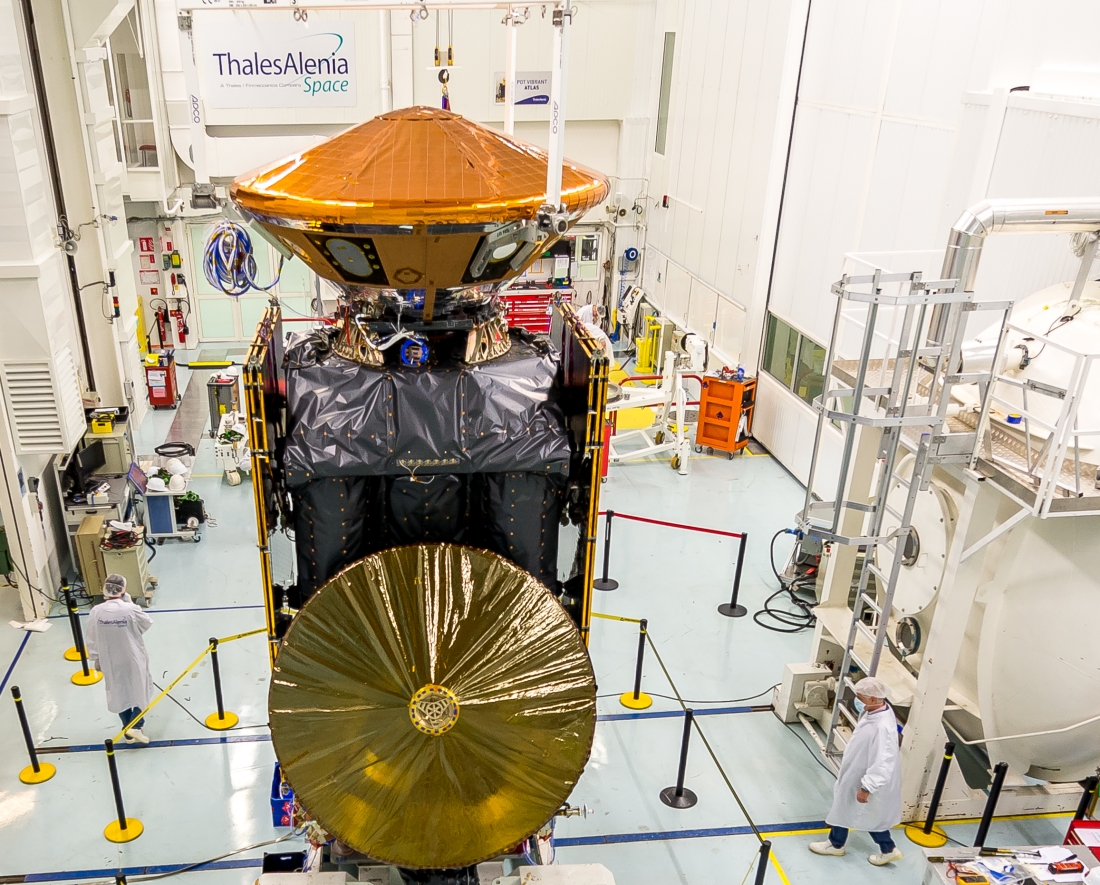Rome, March 14, 2016 - Thales Alenia Space is happy to announce today that Europe’s ExoMars spacecraft was successfully launched from the Baikonur Cosmodrome in Kazakhstan using a Proton-M Rocket. After a successful separation from Breeze as expected, a nominal solar panels deployment, ExoMars has sent its first positive “health check”.
Its long journey of almost 500 million km through space has started, aiming for the Red Planet that has fascinated humanity from time immemorial. Among the trace gases that the mission will study, methane is particularly interesting, as on Earth it is often an indicator of life. This first ExoMars mission will try learn more about methane, its concentration, and distribution. It will also seek to establish if its origin is biological or geological – a challenge facing the instruments carried by ExoMars.
"It is not easy to describe our excitement after the success of this historical launch – stated Donato Amoroso, CEO of Thales Alenia Space Italia and Deputy CEO of Thales Alenia Space – Once again the technology, know-how and experience of Thales Alenia Space make us key players in space exploration. Today we are celebrating the first crucial stage of an extraordinary international program, fruit of the cooperation between the agencies and industry – continued the CEO – but we are ready to take the next steps in ExoMars, thanks to the professional work of our engineers and specialized technicians.”

The ExoMars 2016 mission is composed of an orbiting module, called TGO (Trace Gas Orbiter) that was integrated at the Thales Alenia Space plant in Cannes, and a descent module, called EDM (Entry descent landing Demonstrator Module), built at the Thales Alenia Space plant in Turin.
Finmeccanica’s Avionics and Space Systems Division also contributes to the ExoMars program by supplying generators and units on the EDM module, with the stellar attitude sensors for the TGO and with the core of the CASSIS optronic observation instrument.
Telespazio (Finmeccanica 67%, Thales 33%), through its subsidiary Telespazio VEGA Deutschland, is in charge of developing the Mission Control System for monitoring and controlling the TGO in 2016.
The spacecraft will arrive on Mars after a cruise of about seven months. On 16 October 2016, the descent module will separate from the orbiter and, after a three-day coasting phase, will reach the boundary of the Martian atmosphere, the so-called entry interface point, located approx.120 km above the planet’s surface.
Photos: © Thales Alenia Space/Imag[IN]
Thales Alenia Space, a joint venture between Thales (67%) and Finmeccanica (33%), is a key European player in space telecommunications, navigation, Earth observation, exploration and orbital infrastructures. Thales Alenia Space and Telespazio form the two parent companies' “Space Alliance”, which offers a complete range of services and solutions. Because of its unrivaled expertise in dual (civil/military) missions, constellations, flexible payloads, altimetry, meteorology and high-resolution optical and radar instruments, Thales Alenia Space is the natural partner to countries that want to expand their space program. The company posted consolidated revenues of 2.1 billion euros in 2015, and has 7,500 employees in eight countries. www.thalesaleniaspace.com
Thales Alenia Space anuncia con satisfacción que la nave europea ExoMars ha sido lanzada con éxito desde el cosmódromo de Baikonur en Kazajistán mediante un cohete Proton Breeze M.
Ha comenzado su largo viaje por el espacio hacia el planeta rojo, que ha fascinado a la humanidad por tiempos inmemoriales. Entre los gases traza que estudiará la misión, el metano es especialmente interesante, ya que en la Tierra es a menudo un indicador de vida. Esta primera misión ExoMars tratará de conocer más sobre el metano, su concentración y su distribución. También tratará de establecer si su origen es biológico o geológico – un reto al que se enfrentarán los instrumentos a bordo de ExoMars.
“No es fácil describir nuestra emoción tras el éxito de este lanzamiento histórico – dijo Donato Amoroso, CEO de Thales Alenia Space Italia y vice-director general de Thales Alenia Space – Una vez más la tecnología, experiencia y saber hacer de Thales Alenia Space nos convierte en actores principales en la exploración espacial. Hoy celebramos este primer paso crucial de un programa internacional extraordinario, fruto de la cooperación entre agencias e industria – continuó el CEO – y estamos preparados para llevar a cabo los siguientes pasos en ExoMars, gracias al trabajo profesional de nuestros ingenieros y técnicos especializados.”
La misión ExoMars 2016 está compuesta por un módulo orbitador, llamado TGO (Trace Gas Orbiter – orbitador de gases traza) que ha sido integrado en la planta de Thales Alenia Space en Cannes, y un módulo de descenso, llamado EDM (Entry descent landing Demonstrator Module – módulo demostrador de entrada, descenso y aterrizaje), fabricado en la planta de Thales Alenia Space en Turín.[[asset:image:144881 {"mode":"original","align":"center","field_admin_bool_link_target":[0],"field_admin_bool_image_filter":[0]}]]
Thales Alenia Space España, por su parte, ha participado con el suministro de la red de distribución de radiofrecuencia (RFDN) del sistema de comunicaciones del TGO.
La División de Aviónica y Sistemas Espaciales de Finmeccanica contribuye también al programa ExoMars suministrando generadores y unidades en el módulo EDM, con los sensores estelares de posición para el TGO y con el núcleo del instrumento optrónico de observación CASSIS.
Telespazio (Finmeccanica 67%, Thales 33%), a través de su subsidiaria Telespazio VEGA Deutschland, está a cargo del desarrollo del Sistema de Control de la Misión para la monitorización y control del TGO en 2016.
La nave llegará a Marte tras un viaje de unos siete meses. El 16 de octubre de 2016 el módulo de descenso se separará del orbitador y, tras una fase de acercamiento de tres días, alcanzará la frontera de la atmósfera marciana, el llamado punto interfaz de entrada, a unos 120 km por encima de la superficie del planeta.


